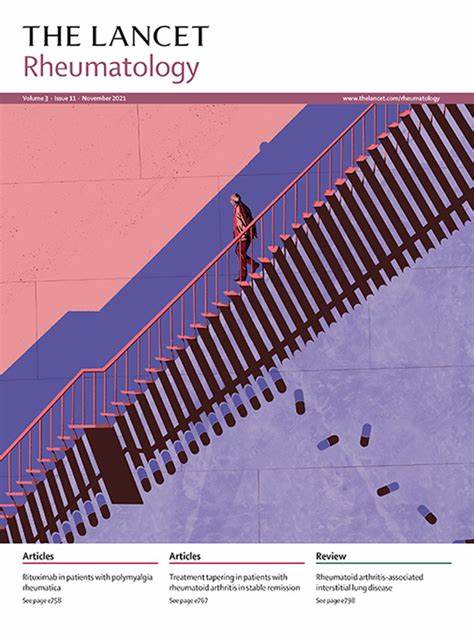Cognitive functional therapy with or without movement sensor biofeedback versus usual care for chronic, disabling low back pain (RESTORE): 3-year follow-up of a randomised, controlled trial
IF 16.4
1区 医学
Q1 RHEUMATOLOGY
引用次数: 0
Abstract
Background
Interventions for low back pain typically produce small and short-term effects. Cognitive functional therapy (CFT) has shown large effects up to 12 months, but long-term effects are unclear. We aimed to compare the long-term (3-year) effectiveness of CFT, delivered with or without movement sensor biofeedback, with usual care for patients with chronic disabling low back pain.
Methods
The RESTORE trial was a randomised, controlled, three-arm parallel group, phase 3, clinical trial that investigated CFT delivered with or without biofeedback compared with usual care for the treatment of chronic low back pain. Treatment was delivered in 20 primary care physiotherapy clinics in Australia. This study is the 3-year follow-up of the RESTORE trial. We recruited adults (aged ≥18 years) with low back pain lasting more than 3 months with at least moderate pain-related physical activity limitation and average back pain of at least 4 on a 0–10 scale. Participants were randomly assigned (1:1:1) via a centralised adaptive schedule to usual care, CFT only, or CFT plus biofeedback. At the 1-year follow-up, all participants were invited to provide consent to be followed up 2 years later—ie, 3 years after randomisation. The primary outcome was pain-related physical activity limitation, self-reported via the Roland Morris Disability Questionnaire (0–24 scale) at 3 years. The secondary outcome was pain intensity at 3 years, assessed using the numeric pain rating scale. Adverse event data were not collected at the 3-year follow-up. All outcomes were assessed in the intention-to-treat population. Participants in both CFT groups received up to seven treatment sessions over 12 weeks plus a booster session at 26 weeks. Physiotherapists and patients were not masked. People with lived experience of chronic low back pain were involved in the study design and conduct. This trial is registered with the Australian New Zealand Clinical Trials Registry (ACTRN12618001396213).
Findings
Between Oct 23, 2018, and Aug 3, 2020, 1011 people were assessed for eligibility for the RESTORE trial. 492 (49%) were eligible and randomly assigned to one of three treatments; 164 (33%) to CFT only, 163 (33%) to CFT plus biofeedback, and 165 (34%) to usual care. At the 1-year follow-up, 359 (73%) of 492 participants provided consent to be contacted to complete the 3-year questionnaire. 312 (87%) of those 359 participants were successfully followed up at 3 years, with similar proportions across each treatment group; 104 (63%) of 164 in the CFT only group, 106 (65%) of 163 in the CFT plus biofeedback group, and 102 (62%) of 165 in the usual care group. 188 (60%) of 312 participants were female, 124 (40%) were male, and the mean age was 48·1 years (SD 14·6). CFT only (mean difference –3·5 [95% CI –4·9 to –2·0]) and CFT plus biofeedback (–4·1 [–5·6 to –2·6]) were both more effective than usual care in reducing activity limitation at 3 years. Differences between CFT only and CFT plus biofeedback treatments were small and not significant (mean difference –0·6 [95% CI –2·2 to 0·9]). For pain intensity at 3 years, CFT only (–1·0 [–1·6 to –0·5]) and CFT plus biofeedback (–1·5 [–2·1 to –0·9]) were also more effective than usual care, and differences between CFT only and CFT plus biofeedback were small and not significant (–0·5 [–1·1 to 0·1]).
Interpretation
Treatment sessions of CFT produced sustained effects at 3 years for people with chronic disabling low back pain. These long-term effects are novel and provide the opportunity to markedly reduce the effect of chronic back pain if the intervention can be widely implemented. Implementation requires scaling up of clinician training to increase accessibility and replication studies in diverse health-care systems.
Funding
Australian National Health and Medical Research Council and Curtin University.
认知功能疗法加或不加运动传感器生物反馈对比常规治疗慢性致残性腰痛(RESTORE):一项为期3年的随机对照试验随访。
背景:对腰痛的干预通常产生小而短期的效果。认知功能疗法(CFT)显示出长达12个月的巨大效果,但长期效果尚不清楚。我们的目的是比较有或没有运动传感器生物反馈的CFT与常规护理对慢性致残性腰痛患者的长期(3年)疗效。方法:RESTORE试验是一项随机、对照、三臂平行组、3期临床试验,研究了CFT在有或没有生物反馈的情况下与常规治疗相比治疗慢性腰痛的效果。治疗在澳大利亚的20个初级保健理疗诊所进行。这项研究是RESTORE试验的3年随访。我们招募了腰痛持续3个月以上的成年人(年龄≥18岁),至少有中度疼痛相关的身体活动限制,平均背痛在0-10分中至少为4分。参与者通过集中适应性计划随机分配(1:1:1)到常规护理,仅CFT或CFT加生物反馈。在1年的随访中,所有参与者都被邀请同意在随机化后的2年后(即3年后)进行随访。主要结果是疼痛相关的身体活动限制,3年后通过罗兰莫里斯残疾问卷(0-24量表)自我报告。次要结果是3年时的疼痛强度,使用数字疼痛评定量表进行评估。3年随访期间未收集不良事件数据。在意向治疗人群中评估所有结果。两个CFT组的参与者在12周内最多接受7次治疗,并在26周时接受一次强化治疗。物理治疗师和病人没有被蒙面。有慢性腰痛生活经验的人参与了研究的设计和实施。该试验已在澳大利亚新西兰临床试验登记处注册(ACTRN12618001396213)。结果:在2018年10月23日至2020年8月3日期间,1011人被评估为RESTORE试验的资格。492例(49%)符合条件,随机分配到三种治疗中的一种;仅CFT组164例(33%),CFT加生物反馈组163例(33%),常规护理组165例(34%)。在1年的随访中,492名参与者中有359名(73%)同意联系完成为期3年的问卷调查。359名参与者中有312人(87%)在3年后成功随访,每个治疗组的比例相似;仅CFT组164例中有104例(63%),CFT加生物反馈组163例中有106例(65%),常规护理组165例中有102例(62%)。312例受试者中,女性188例(60%),男性124例(40%),平均年龄48.1岁(SD 14.6)。仅CFT(平均差值为-3·5 [95% CI为-4·9至-2·0])和CFT加生物反馈(-4·1[-5·6至-2·6])在减少3年活动限制方面都比常规护理更有效。单纯CFT与CFT加生物反馈处理之间的差异很小且不显著(平均差异为- 0.6 [95% CI -2 ~ 0.9])。对于3年疼痛强度,CFT单独治疗(-1·0[-1·6至-0·5])和CFT加生物反馈治疗(-1·5[-2·1至-0·9])也比常规治疗更有效,CFT单独治疗和CFT加生物反馈治疗之间的差异很小,不显著(-0·5[-1·1至0·1])。解释:CFT治疗对慢性下腰痛患者产生持续3年的效果。这些长期效果是新颖的,如果干预措施可以广泛实施,将为显著减少慢性背痛的影响提供机会。实施需要扩大临床医生培训,以增加各种卫生保健系统的可及性和重复性研究。资助:澳大利亚国家卫生和医学研究委员会和科廷大学。
本文章由计算机程序翻译,如有差异,请以英文原文为准。
求助全文
约1分钟内获得全文
求助全文
来源期刊

Lancet Rheumatology
RHEUMATOLOGY-
CiteScore
34.70
自引率
3.10%
发文量
279
期刊介绍:
The Lancet Rheumatology, an independent journal, is dedicated to publishing content relevant to rheumatology specialists worldwide. It focuses on studies that advance clinical practice, challenge existing norms, and advocate for changes in health policy. The journal covers clinical research, particularly clinical trials, expert reviews, and thought-provoking commentary on the diagnosis, classification, management, and prevention of rheumatic diseases, including arthritis, musculoskeletal disorders, connective tissue diseases, and immune system disorders. Additionally, it publishes high-quality translational studies supported by robust clinical data, prioritizing those that identify potential new therapeutic targets, advance precision medicine efforts, or directly contribute to future clinical trials.
With its strong clinical orientation, The Lancet Rheumatology serves as an independent voice for the rheumatology community, advocating strongly for the enhancement of patients' lives affected by rheumatic diseases worldwide.
 求助内容:
求助内容: 应助结果提醒方式:
应助结果提醒方式:


